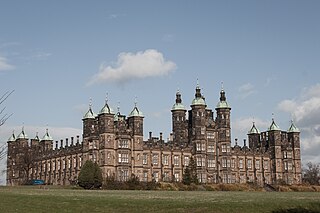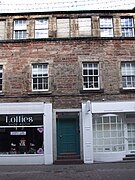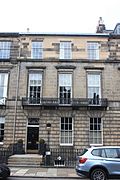Related Research Articles
James Hamilton, 1st Earl of AbercornPC (S) (1575–1618) was a Scottish diplomat for James VI and an undertaker in the Plantation of Ulster, Ireland.

Archibald David Constable was a Scottish publisher, bookseller and stationer.

John Jamieson DD was a Scottish minister of religion, lexicographer, philologist and antiquary. His most important work is the Dictionary of the Scottish Language.

John Kay was a Scottish caricaturist and engraver.

Donaldson's School in Linlithgow is Scotland's national residential and day school, providing education, therapy and care for pupils who are deaf or who have communication difficulties.

This article is a timeline of the history of Edinburgh, Scotland, up to the present day. It traces its rise from an early hill fort and later royal residence to the bustling city and capital of Scotland that it is today.

The Kirk of the Canongate, or Canongate Kirk, serves the Parish of Canongate in Edinburgh's Old Town, in Scotland. It is a congregation of the Church of Scotland. The parish includes the Palace of Holyroodhouse and the Scottish Parliament. It is also the parish church of Edinburgh Castle, even though the castle is detached from the rest of the parish. The wedding of Zara Phillips, the Queen's granddaughter, and former England rugby captain Mike Tindall took place at the church on 30 July 2011. The late Queen Elizabeth II used to attend services in the church on some of her frequent visits to Edinburgh.
The Edinburgh Gazette is a newspaper of record of the Government of the United Kingdom, along with The London Gazette and The Belfast Gazette. It is published by The Stationery Office (TSO), on behalf of His Majesty's Stationery Office (HMSO) in Edinburgh, Scotland. The Crown Agent is, ex officio, the Keeper of the Edinburgh Gazette.
George Heriot was a Scottish goldsmith and member of the Parliament of Scotland. He is perhaps best known as the father of the philanthropist George Heriot, his eldest son.

There have been several town walls around Edinburgh, Scotland, since the 12th century. Some form of wall probably existed from the foundation of the royal burgh in around 1125, though the first building is recorded in the mid-15th century, when the King's Wall was constructed. In the 16th century the more extensive Flodden Wall was erected, following the Scots' defeat at the Battle of Flodden in 1513. This was extended by the Telfer Wall in the early 17th century. The walls had a number of gates, known as ports, the most important being the Netherbow Port, which stood halfway down the Royal Mile. This gave access from the Canongate which was, at that time, a separate burgh.
John Mein was a Boston, Massachusetts, bookseller and publisher in the time before the American Revolution. Mein started Boston's first circulating library, and with his business partner, John Fleeming, Mein published the Loyalist newspaper, the Boston Chronicle, the first semi-weekly in New England.
Alexander Donaldson was a Scottish bookseller, publisher, and printer. Donaldson was the founding publisher of the weekly newspaper, the Edinburgh Advertiser. He was also known for selling cheap copies of books after their copyright had expired in disregard to London booksellers' opinions on literary property.

Sir James Donaldson was a Scottish printer and newspaper publisher. He bequeathed a large part of his estate to the founding of Donaldson's Hospital.
Events from the year 1830 in Scotland.
Margaret Douglas, Countess of Bothwell was a Scottish aristocrat and courtier.

Heriot Row is a highly prestigious street in central Edinburgh, virtually unchanged since its original construction in 1802. From its inception to the present day in remained a top address in the city and has housed the rich and famous of the city's elite for 200 years
Claud Muirhead (1782–1872) was an 18th-century Scottish printer and publisher and editor of the Edinburgh Advertiser.
James Muirhead (1830–1889) was a 19th century Scottish scholar and professor of civil law at Edinburgh University. He gives his name to the Muirhead Prize in Civil Law at the University.
Archibald Stewart was a Scottish merchant and Provost of Edinburgh.

James Gray was a Scottish goldsmith working in Edinburgh during the reigns of Mary, Queen of Scots and James VI of Scotland.
References
- ↑ Bulloch, John; John Alexander Henderson (1892). Scottish notes and queries (Digitized 5 Aug 2005 ed.). D. Wyllie and son. p. 85.
- ↑ "Anatomy of Political Parties and their Organs on Non-Intrusion". The London and Edinburgh Magazine. Vol. 1, no. 4. Cornhill: Smith, Elder & Co. 1841. p. 253.
- ↑ "The Edinburgh Advertiser, Edinburgh, Midlothian, Scotland, 1772–1826". Newspapers.com. 31 January 2021. Retrieved 1 February 2021.
- 1 2 "The Edinburgh advertiser". Library of Congress . Retrieved 1 February 2021.
- ↑ "Google News Archive Search". news.google.com. Retrieved 1 February 2021.
- ↑ "Newspapers". National Library of Scotland . Retrieved 1 February 2021.
- 1 2 Couper, William James (1908). The Edinburgh periodical press: being a bibliographical account of the newspapers, journals, and magazines issued in Edinburgh from the earliest times to 1800. Vol. 2 (Digitized 14 Aug 2007 ed.). E. Mackay. pp. 106–114.
- 1 2 "Scottish Book Trade Index (SBTI)". nls.uk. National Library of Scotland. Archived from the original on 3 August 2009. Retrieved 18 April 2010.
- ↑ Couper, P. 106
- ↑ Boase, Frederic (1897). Modern English biography: containing many thousand concise memoirs of persons who have died since the year 1850, with an index of the most interesting matter. Vol. 2 (Digitized 5 Jun 2008 ed.). Netherton and Worth. p. 1906.
- ↑ Clow, Archibald; Nan L. Clow (1992). The chemical revolution: a contribution to social technology. Classics in the history and philosophy of science. Vol. 8. Taylor & Francis. p. 259. ISBN 2-88124-549-8.
- ↑ Wilson, John (1855). James Frederick Ferrier (ed.). The Works of Professor Wilson of the University of Edinburgh: Noctes ambrosianae. Vol. 2 (Digitized 9 Aug 2007 ed.). W. Blackwood. p. 126.
- ↑ "Scottish Book Trade Index". nls.uk. National Library of Scotland. Archived from the original on 13 September 2007. Retrieved 25 April 2010.
- ↑ Macaulay, James (1867). The Leisure hour (Digitized 18 Oct 2007 ed.). p. 86.
- ↑ Couper, p. 106, 111
- 1 2 Couper, p. 107
- ↑ Noble, Andrew; Patrick Scott Hogg (2002). The Canongate Burns. Canongate classics. Vol. 104. Canongate U.S. p. 454. ISBN 1-84195-380-6.
- ↑ Highfill, PH Highfill; KA Burnim; EA Langhans (1982). A Biographical Dictionary of Actors, Volume 8, Hough to Keyse: Actresses, Musicians, Dancers, Managers, and Other Stage Personnel in London, 1660–1800. Vol. 8. SIU Press. p. 98. ISBN 0-8093-0919-X.



